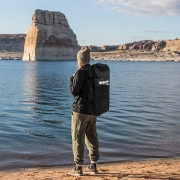Inflatable Paddle Board vs Solid: Which is Right for You?
Choosing the right paddle board is crucial for maximizing enjoyment and performance during water activities. Whether you’re a seasoned enthusiast or a beginner looking to explore the world of paddleboarding, understanding the differences between inflatable and solid boards is essential.
In this article, we will delve into the characteristics, benefits, and drawbacks of each type of board, allowing you to make an informed decision for your next water adventure.
Understanding Inflatable Paddle Boards
One of the key advantages of inflatable boards is their portability and ease of transportation. These boards can be deflated and rolled up into a compact size, making them convenient to carry and store in small spaces such as a backpack or the trunk of a car.
Inflatable paddle boards offer excellent storage convenience. Unlike their solid counterparts, these boards can be stored in a deflated state, saving precious space in your garage or closet.
Exploring Solid Paddle Boards
Solid paddle boards, also known as hard boards or rigid boards, are crafted from materials such as fiberglass or epoxy. These boards offer enhanced stability and stiffness, providing exceptional control and performance. Their solid construction allows for superior speed and maneuverability.
The main drawback of solid paddle boards lies in their transportation and storage. Due to their rigid structure, these boards can be challenging to transport, especially if you lack a dedicated roof rack or a spacious vehicle.
Performance and Versatility
When considering the performance of inflatable paddle boards, it is crucial to evaluate factors such as speed, maneuverability, and stability. While inflatable boards may not achieve the same level of speed as solid boards, they offer stability and ease of use, making them suitable for various water activities such as touring, yoga, and even surfing for beginners.
Solid paddle boards excel in terms of speed, maneuverability, and stability. Their rigid construction allows for precise control and swift turns, making them ideal for experienced users and adrenaline-fueled water adventures.
Portability and Storage

In terms of portability. Deflating the board allows for easy storage and transportation. When deflated, these boards can be rolled up and packed into a backpack or a carrying case, making them the perfect companion for travelers or those with limited storage space.
Solid paddle boards, on the other hand, may pose challenges in terms of portability. Their rigid structure makes them difficult to transport, especially if you don’t have the necessary equipment like a roof rack.
Durability and Maintenance
In terms of durability, inflatable paddle boards are designed to withstand punctures, impacts, and UV rays. These boards are typically constructed using high-quality materials such as military-grade PVC, ensuring they can endure the rigors of different water conditions.
Solid paddle boards, while generally durable, are susceptible to damage and may require repairs over time. The responsibility of maintaining the board’s integrity falls on the user, who must promptly address any cracks, dings, or scratches to ensure longevity. Proper storage and regular maintenance are crucial to keep solid paddle boards in top condition.
Suitability for Different Water Environments

When comparing the performance of inflatable and solid paddle boards in different water environments, several factors come into play. In calm waters, both types of boards can be maneuvered easily. solid boards may excel in choppy conditions or rough seas due to their superior stability and control.
For river or whitewater adventures, inflatable paddle boards can be a suitable choice as they offer great stability and resistance to damage from rocks or obstacles. Solid boards, while capable of withstanding rough conditions, may require more skill and experience to navigate such environments safely.
User Experience and Skill Levels
Inflatable paddle boards are often recommended for beginners due to their stability and ease of learning. These boards provide a forgiving platform for building confidence on the water and developing basic paddling skills. With their wide base and buoyant nature, newcomers can focus on learning proper paddling techniques without worrying too much about balancing.
Solid paddle boards, on the other hand, may require a certain level of balance and control to fully enjoy their superior speed and maneuverability. Experienced users can master advanced techniques and maneuvers on solid boards, pushing their skills to the limit and embracing the challenges of more demanding water activities.
Safety Considerations
For inflatable paddle boards, safety features such as board stability and buoyancy are inherent due to their design and materials. Leash usage and safety precautions should always be observed to prevent accidents and ensure the safety of both the paddler and others in the water.
Solid paddle boards also offer stability, but the user must be more mindful of their personal safety in rough conditions. Proper technique and experience are necessary to maintain control and prevent accidents in challenging water environments.
Conclusion
Selecting the right paddle board is crucial to maximizing enjoyment and safety during water adventures. By considering individual needs, activity levels, and budget constraints, individuals can make an informed decision when choosing between inflatable and solid paddle boards.






